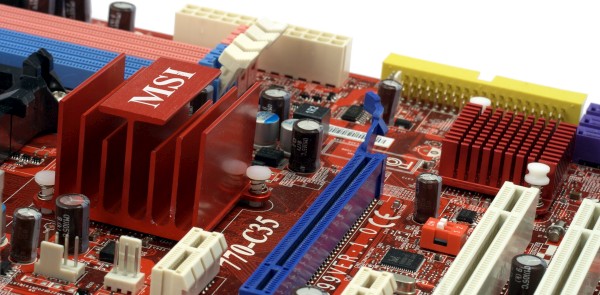We get a lot of requests for reviews of simple, inexpensive motherboards on account of people buy them more often. Well, it's only natural that any reviewer prefers innovative products to classic solutions. Aside from personal interest, the reason is that such reviews are also read by users not looking for upgrades, just out of curiosity. But don't worry, we're not going to forget about mainstream motherboards at all.
Design
Inexpensive motherboards based on discrete chipsets are reasonably aimed at somewhat conservative users, not just those trying to save money. Hence the higher priority of PCI slots. Note that all of them remain available even after you install a dual-slot graphics card.
The board is narrower than standard, so its layout is pretty dense despite the lack of additional controllers. Be careful when you connect or disconnect the power cable, because this edge is not fastened to the enclosure.
Optional features include the red overclocking modes switch, traditional for nearly all MSI motherboards. It lets you increase the reference frequency by 10%, 15% or 20% without entering BIOS. Considering there are programs like AMD OverDrive, the switch isn't that useful.
One thing we'd actually like this motherboard to offer is a more reliable tool for recovering BIOS after failed firmware upgrades. Formally, the motherboard should let you boot from a flash drive in case the primary (and only) firmware gets damaged. Sadly, it's also prone to malfunctioning. Gigabyte looks better in this area, offering two BIOS chips. Especially, if you don't have a repair center around.
If you use legacy devices, you'll like the COM port on the rear panel. There's no S/PDIF Out, though.
The cooling system is simple, but it does the job well, providing all the cooling this chipset needs.
The VRM has 5 channels, 3 FETs per each. There are 10 x 820µF and 4 x 270µF solid capacitors. The motherboards supports processors with up to 125W TDP.
The bundle includes a couple of SATA cables (no latches) and a PATA cable, as well as a user's manual.
MSI was one of the first to introduce means for searching manufacturer's website for drivers. Of course, there's another tool for searching for BIOS firmware. In other respects, the set of software is kind of mediocre. Stylish proprietary monitoring tools became a thing of the past.
Write a comment below. No registration needed!



